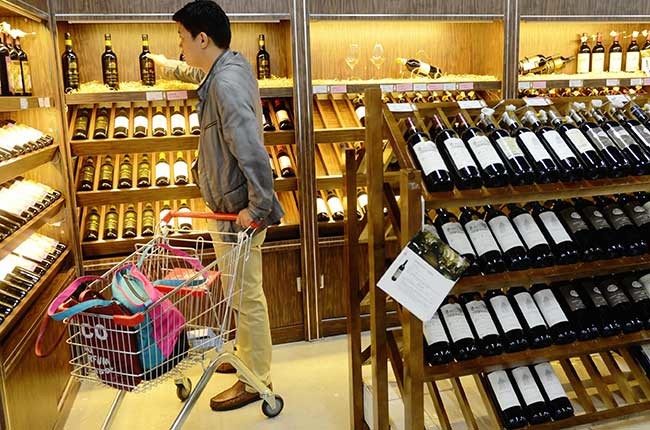Demei's View - Wine Communication from a Chinese Winemaker
On June 3rd 2014, the China Alcoholic Drinks Association (CADA) launched a new certification mark* designated for ‘Estate Wine’ (Registration number 5504363) in Beijing.
The new trademark provides extra protection to wines made in Chinese wineries under the Trademark Law of the People's Republic of China, which is expected to further encourage a regulated and orderly development of Estate Wines.
The ‘Estate Wine (葡萄酒酒庄酒)’ is a certification mark registered by the CADA at China Trademark Office (CTMO). As the legal holder of the trademark, the CADA has laid down its management regulations, and has filed them to the CTMO for record. Any lawfully registered wine-making company that holds the ‘national industrial production permit (QS)’ licence can apply to use this trademark through the CADA.

For wineries to qualify to use the trademark, they’ll have to own vineyards under their full control, and fulfil the requirements in terms of production scale, yields, distance between estate building and vineyards, storage facilities and professional qualifications of winemaking staff.
The wines made, on the other hand, will have to be made under the ‘technical regulation for Estate Wines (酒庄酒生产技术规范 QS)’ and the national quality standard ‘GB15037’, bottled on site, and examined by a professional panel.
The regulations attached to the Estate Wine trademark mirror some of the managing methods of overseas wine regions, but also reflect the current situation of Chinese wine industry. For example the regulation that ‘production capacity should be above 750hl’ is based on the requirements of a QS licence issued by the quality and technical supervision department of China.
A committee has been set up by the CADA to directly ‘examine, supervise and manage’ the usage of the Estate Wine trademark. The committee is formed of professionals from the trade, members of trade associations and production region management institutions, and also representatives from the media and companies using the trademark.
As for the ‘professional panel’ assigned to examine the sensual quality of the wine, not only experts from the trade have been recruited, but journalists and consumers have also been invited to take part in the examination process, so as to guarantee the ‘authoritativeness’ of the results.
By involving the media and consumers in the management process of the trademark, the CADA expect to raise the trademark’s credibility in the market.

Any wine bearing an Estate Wine certification mark should ‘be made under certain restrictions; the producing process should be traceable, and reach certain standards’.
Because Estate Wines are usually produced on a small scale in China, they may have a very limited ability to promote their products, let along maintaining an impactful presence among consumers. However, the CADA can consolidate wineries with similar production philosophy and promote them all together thus attracting more market attention. Bearers of the trademark can also supervise each other so as to further enhance the quality.
The Estate Wine trademark not only regulates the market, but also provides an easy choice for consumers. Through the promotion and marketing efforts of the CADA, the Estate Wine mark will become well-known to consumers and hold a bigger impact to the market. Quality-conscious consumers can simply choose a wine bearing this mark at ease, as the trademark itself is a guarantee of quality.
For imported wines, the story is rather different.
With a wide variety of wine products floating in the Chinese market, it’s always difficult for consumers to make a choice. Language barriers and confusion caused by ownership disputes of Chinese trademarks make it even worse. Many regions and companies are wondering how they can protect their trademarks while expanding their brand influence in this upcoming market.
As a European wine producing region, Champagne tackled this problem in two ways. It not only gained geographic indication protection from the China State Bureau of Quality and Technical Supervision in 2013, but also successfully registered its Chinese name ‘香槟’ as a collective mark with the trademark office. By doing so, Champagne became the very first European wine region to hold a collective trademark in China.
In Europe, geographical indication have long been protected by law, thus holds strong restraining force and massive social influence. However, in China geographical denomination protection is only stated in one regulation issued by one of the government departments, which means that the protection has much less legal effect than the European laws.
Although ‘干邑 (Cognac)’, ‘苏格兰威士忌(Scotch Whisky)’ and ‘纳帕(Napa)’ are granted with geographic indication protection status by China’s General Administration of Quality Supervision in 2009, 2010 and 2012 respectively under the ‘geographical indication protection regulations (地理标志保护条例)’, it has thus far had little effect in the market as the ‘regulation’ is far less forceful than the trademark law.
Despite being the biggest source of imported wines in China, Bordeaux seems to be putting more efforts into promoting its wines rather than protecting its trademarks. Learning from Champagne, this year Bordeaux is also attempting to register a few collective trademarks, which have been met by various ‘technical problems’.

The reason was that Bordeaux wines are already widely sold in China. In other words, when Chinese people started to import Bordeaux wines in massive amounts 15 years ago, the market’s development speed was underestimated, and the region was late in protecting its names. There are many other companies facing similar difficulties.
Complaints can’t solve problems. How can you gain the rights you deserve without actively claiming for it before it’s too late?
Fortunately a Beijing court recently ruled that a company couldn’t register the Chinese brand name ‘露喜龙’ because it’s one of the Chinese translations for wine region ‘Roussilon’. The victory provides a good example for foreign imported wines seeking for trademark protections, and will perhaps become the turning point for confusing wine name translations in China.
The latest updated ‘Regulations for the Implementation of the Trademark Law of the People's Republic of China’ was put to use on 1st May 2014.
In Article 4 it states, ‘geographical indications, which are defined by Article 16 of the trademark law, can be registered as certification marks or collective marks based on the trademark law and this regulation.’ These changes in the law appeared for a reason.
Now the Estate Wine trademark is open for application. The first batch of certified wines is expected to be released after various examinations by mid-August.
To build a more regulated market and to further protect wine trademarks, first of all the right-holders need to claim for the rights. Consumers troubled by the chaos of the market will also be called upon to give it a push—otherwise, what’s the point of regulating the market?
Many regions or wine-producing countries have been through a similarly chaotic period. Hopefully China will get over the era of disorder soon enough.
*A certification mark Referred to in this Law is a sign controlled by an organization capable of monitoring certain goods or services for use by organizations or persons other than such an organization on their goods or services to certify the geographical origin, material, mode of manufacture, quality or other specific characteristics of the goods or services. (Article 3, Chapter I of the Trademark Law of the People's Republic of China)
**Professor Li Demei is the vice-general-secretary of the wine division of the CADA
Translated by Sylvia Wu / 吴嘉溦
All rights reserved by Future plc. No part of this publication may be reproduced, distributed or transmitted in any form or by any means without the prior written permission of Decanter.
Only Official Media Partners (see About us) of DecanterChina.com may republish part of the content from the site without prior permission under strict Terms & Conditions. Contact china@decanter.com to learn about how to become an Official Media Partner of DecanterChina.com.



Comments
Submit